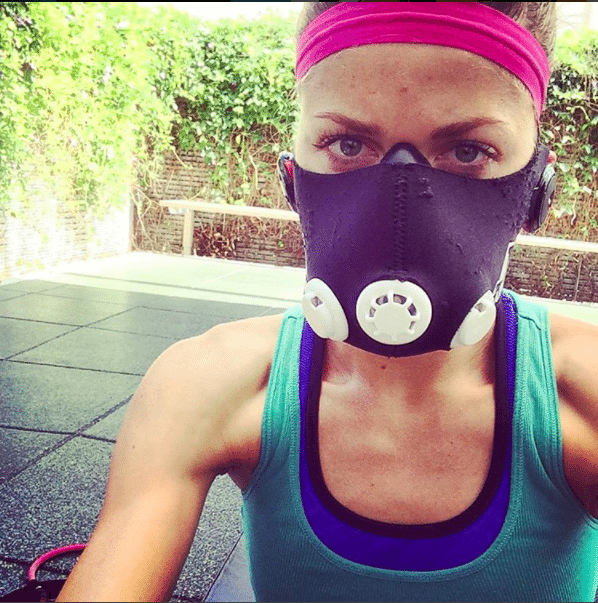I’ve always been a bit skeptical of the Training Mask’s actual benefits—can that really replace high altitude and give the same physiological adaptations? From what I know of environmental exercise physiology, it just seems too good to be true (just like the “expand-a-lung” device for that matter). The Training Mask’s effects might be minor at best and probably not worth buying—or so I thought. Recently my mind has changed! (Btw, that is what it’s all about—with more research, and more breakthroughs, it’s ok to have changing and evolving opinions over time, just ask Dr. Tim Noakes ;)). Some smart minds in the sports world have come out with cool ideas on how to use the mask in a more unconventional way where it can still be of benefit but not necessarily for the original purported reasons.
During race season it’s better to focus on specific sessions rather than messing around with new equipment (at best you’ll waste time doing something new, at worst you could injure or overly fatigue yourself). But the off-season is a great time to experiment! The stakes are low, plus playing around with new toys and movement patterns can add some much-needed novelty to your training. In the long run, it will keep you mentally and physically fresh to change things up.
Also, you don’t even have to be a dedicated athlete-in-training to benefit. What you’ll read below is that the Training Mask is all about developing better breathing and if you’re looking to improve your health and balance out stress, then this is for you! So take it on one of your workouts and go for it!
So here I am now saying, yes, the Training Mask is one way to shake things up and improve yourself, so give it a shot if you have a chance to buy one.
How To Use The Training Mask
- Benefits:
- Trains the diaphragm to take very deep breaths, which is especially useful for recovery between high intensity intervals
- According to research conducted by Harvard Medical School, “deep abdominal breathing encourages full oxygen exchange — that is, the beneficial trade of incoming oxygen for outgoing carbon dioxide. Not surprisingly, it can slow the heartbeat and lower or stabilize blood pressure.”
- When to use the mask:
- Wear during warm up & pre-workout dynamic exercises
- Wear during recovery between intervals
- How frequently:
- Warm up – every day
- Between intervals – 2-3 times a week*
- When you’ll see results:
- Three weeks
- Cautions:
- With any “new stress,” start gradually:
- *Start conservatively and wear it during recovery only between intervals ONCE week. Build up to 2 then 3 times a week slowly.
- Never use the mask during long, hard, or key sessions. If you’ve adapted to wearing the mask during recovery between intervals, you can try using it during short, low intensity exercise sessions (like a functional strength circuit or a short, sub-MAF run or bike)
My Thoughts + Other Info To Consider…
- The mask doesn’t actually simulate altitude, BUT it does make breathing more difficult. Even if you’re not getting the physiological effects of real altitude training, you’re still getting the psychological benefits of training your brain to remain calm and breathe deeply when breathing is uncomfortably restricted.
- Although the mask doesn’t impact red blood cells like real altitude training, it does make your breathing muscles work harder, and this can have a positive training effect (to a small degree).
- CO2 builds up in the mask so you’re forced to inhale more than normal, and the body adapts to that in a positive way.
- The mask helps improve diaphragmatic breathing. But aside from training, I’d like to add this can positively benefit your overall health by activating the parasympathetic nervous system, i.e. rest and digest mode.
- Physiological benefits aside, I think the mask can help cultivate the mental toughness necessary to dig deep during a race when things are really uncomfortable. The mask makes one of our most basic bodily functions – breathing – significantly more difficult. So, if you can get used to that level of discomfort on a consistent basis, then you’ll be able to control “the central governor” better during demanding race scenarios.
Still, A Gimmick?
There are plenty of people who still think the mask is a load of bull. Just Google search for “training mask scam.” I mean, it’s not going to shave an hour off your Ironman or marathon time, but there could be side benefits that help the overall picture and if it fits in your budget, I say WHY NOT?! It’s fun to try new things and as long as you don’t go overboard (a 2-hour long run looking like Darth Vader) then there’s no harm.
Resources
https://www.trainingmask.com/interval-breathing-recovery-protocol/
http://www.health.harvard.edu/mind-and-mood/relaxation-techniques-breath-control-helps-quell-errant-stress-response

